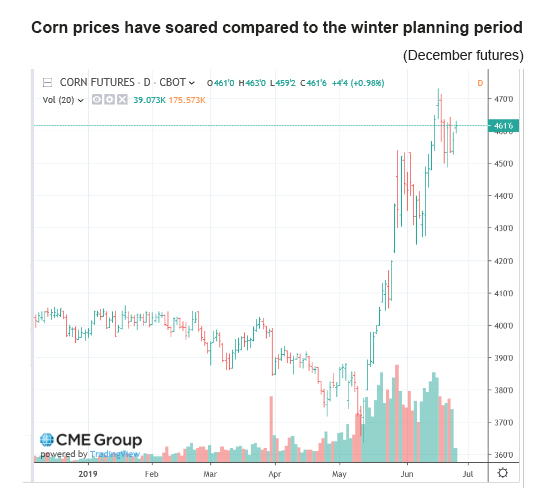We recently sponsored a webinar “Sorting Through the Implications of a Wet, Slow Spring,” featuring Agriculture Economic Insights co-founders Brent Gloy and David Widmar. Below we summarize the steps they outlined for adjusting to planting and market changes.
Even if your operation hasn’t been directly impacted, this year’s slow, wet spring has changed prospects for 2019, and your initial profitability projections likely are outdated. It’s time to reassess where you are financially and make adjustments where needed to optimize your marketing results in 2019.
Start by writing a summary of what has happened on your farm, said David Widmar: “What got planted, what didn’t? What lessons did you learn from this year? What would you do differently?”
This exercise is a good investment of your time, Widmar said, because it helps you think through the decisions you ultimately make and also serves as a reminder of timing -- your thinking at the time and how the wet spring played out.
Now move onto the critical task of updating your operating budget, something that should be a standard, annual activity, said Brent Gloy. Compare what you planned to spend for seed, fertilizer, crop protection, etc. and what you actually paid. Make per-acre adjustments based on actual acreage. Combined with updated yield projections, you can reassess your break-even price per bushel.
“Some people may be in a good place now,” Gloy said. “Prices certainly have improved and maybe their crop is looking pretty good. If you have the chance to make some money this year, you want to take advantage of it and replenish some of your working capital.”
If you have a prevented-planting claim, ask your crop insurance officer to help you figure what your payment will be, Widmar recommended.
“This income can affect the minimum, or target, price you’ll need for your production,” he said.
With an adjusted breakeven as a starting place, review and update your marketing plans. Much has changed over the course of the spring, and expectations for marketing opportunities need to adjust as well, Widmar said. Corn and soybean prices, for example, rallied about $1 per bushel in the face of repeated delays and the corn stocks-to-use tightened from ample at 17% to a possible need for rationing at 12%.

| CORN |
May |
June |
Change
|
| Acres planted (mil.) |
92.8 |
89.8 |
-3 |
| Acres harvested (mil.) |
85.4 |
82.4 |
-3 |
| Yield (bu./A) |
176 |
166 |
-10 |
| Begin stocks (bil.) |
2.095 |
2.195 |
+.10 |
| Production (bil.) |
15.03 |
13.680 |
-1.35 |
| Imports (mil.) |
35 |
50 |
+15 |
| Total supply (bil.) |
17.160 |
15.925 |
-1.235 |
| Total use (bil.) |
14.675 |
14.250 |
-.425 |
| End stocks (bil.) |
2.485 |
1.675 |
-.81 |
| Stocks/use |
17% |
12% |
-5 percentage points |
Among the questions to ask yourself: Have you locked in some higher prices? Did the priced percentage of your expected crop change much with your acreage and expected yield? Do you need to sell less or more -- or change the tool you use for pricing to allow for more uncertainty?
You now are ready to update your financial projections. In addition to cash-flow and income statements, it is important to update balance sheet projections, Widmar said. USDA estimates producers’ working capital has decreased 25% in the past few years and has reached a critical point at the national level. When there is a crop loss like many producers are experiencing, working capital can further erode, although crop insurance can help mitigate the impact.
Gloy urges producers to use their updated information to have constructive conversations with trusted advisors. Lenders and grain marketers can take a lot of the emotion out of the situation because they likely are less emotionally involved, he said.
“They may have ideas about how you can improve your outcome this year,” he said. “And in any case, you can avoid surprises later.”

